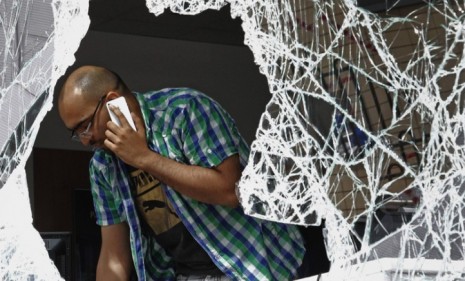5 ways technology shaped the London riots
Looters organized using BlackBerry Messenger, while cleanup efforts have come together on Twitter

For better or worse, social media and smartphones have been at the forefront of the London riots, which have claimed the lives of at least four people and led to the arrest of more than 1,300. Digital messages helped looters turn British cities into chaotic messes — which were subsequently cleaned up by community efforts organized through social media. Here, five ways technology has been a part of the riots:
1. Rioters used BlackBerry Messenger for subversive communication
London authorities say that social media played a key role in helping rioters organize and spread disorder. A sample tweet: "Everyone up and roll to Tottenham f*** the 50 [police]. I hope 1 dead tonight." BlackBerry Messenger (BBM) may have played the most integral role, with rioters using the free instant-messaging service as a secure communication network. "It appears to have acted as their private, encrypted social network," says Christopher Williams in Britain's Telegraph. On Tuesday, the U.K.'s intellectual-property minister, David Lammy, called for a suspension of the service in an effort to thwart rioters' communication.
The Week
Escape your echo chamber. Get the facts behind the news, plus analysis from multiple perspectives.

Sign up for The Week's Free Newsletters
From our morning news briefing to a weekly Good News Newsletter, get the best of The Week delivered directly to your inbox.
From our morning news briefing to a weekly Good News Newsletter, get the best of The Week delivered directly to your inbox.
2. But BlackBerry Messenger may also help identify rioters
While BlackBerry maker Research in Motion (RIM) got quiet when asked to suspend its BBM service, the company says it will "assist the authorities" in trying to identify rioters who used BBM to spread the violence. BBM is, in many cases, less traceable than texting or tweeting, as users are connected through BBM PINs, not usernames or phone numbers. Shortly after RIM agreed to help authorities, the company's blog was hacked in response by an anonymous group referred to as "TeaMpOisoN."
3. Tumblr is fingering rioters, too
On the Tumblr site "Catch a Looter," Britons posted pictures of looters in action, with the intent of identifying and shaming them. However, the site was live for just a day before the webmaster started referring to people to the establishment organization Crimestoppers instead, saying that site was better equipped to handle submissions.
A free daily email with the biggest news stories of the day – and the best features from TheWeek.com
4. Samaritans are organizing through social media
The Twitter account @riotcleanup was launched to get stricken neighborhoods back in order. It already has more than 85,000 followers and has spurred hundreds, if not thousands, of people to take action. "It has been an incredible response," says Dan Thompson, one of the men who helped organize the efforts. "I thought we might get a few people out. But we saw hundreds of people show up with brooms." A similar page on Facebook has nearly 20,000 supporters.
5. But the U.K. government may still crack down
On Thursday, Prime Minister David Cameron said he was considering temporarily blocking messaging services and social-networking sites. When people use social media for violent purposes, "we need to stop them," Cameron says. I'm not so sure, says New York University professor Ramesh Srinivasan, as quoted in The Washington Post. "Cutting off or hacking a communication technology... fails to address the deep-rooted dissatisfaction that drove people to take to the streets" in the first place.
Sources: Bloomberg, Facebook, Marketwatch, NY Times, PC Advisor, Telegraph, TIME, Twitter, Wash. Post, ZD Net
-
 ‘Let 2026 be a year of reckoning’
‘Let 2026 be a year of reckoning’Instant Opinion Opinion, comment and editorials of the day
-
 Why is Iran facing its biggest protests in years?
Why is Iran facing its biggest protests in years?TODAY’S BIG QUESTION Iranians are taking to the streets as a growing movement of civic unrest threatens a fragile stability
-
 How prediction markets have spread to politics
How prediction markets have spread to politicsThe explainer Everything’s a gamble